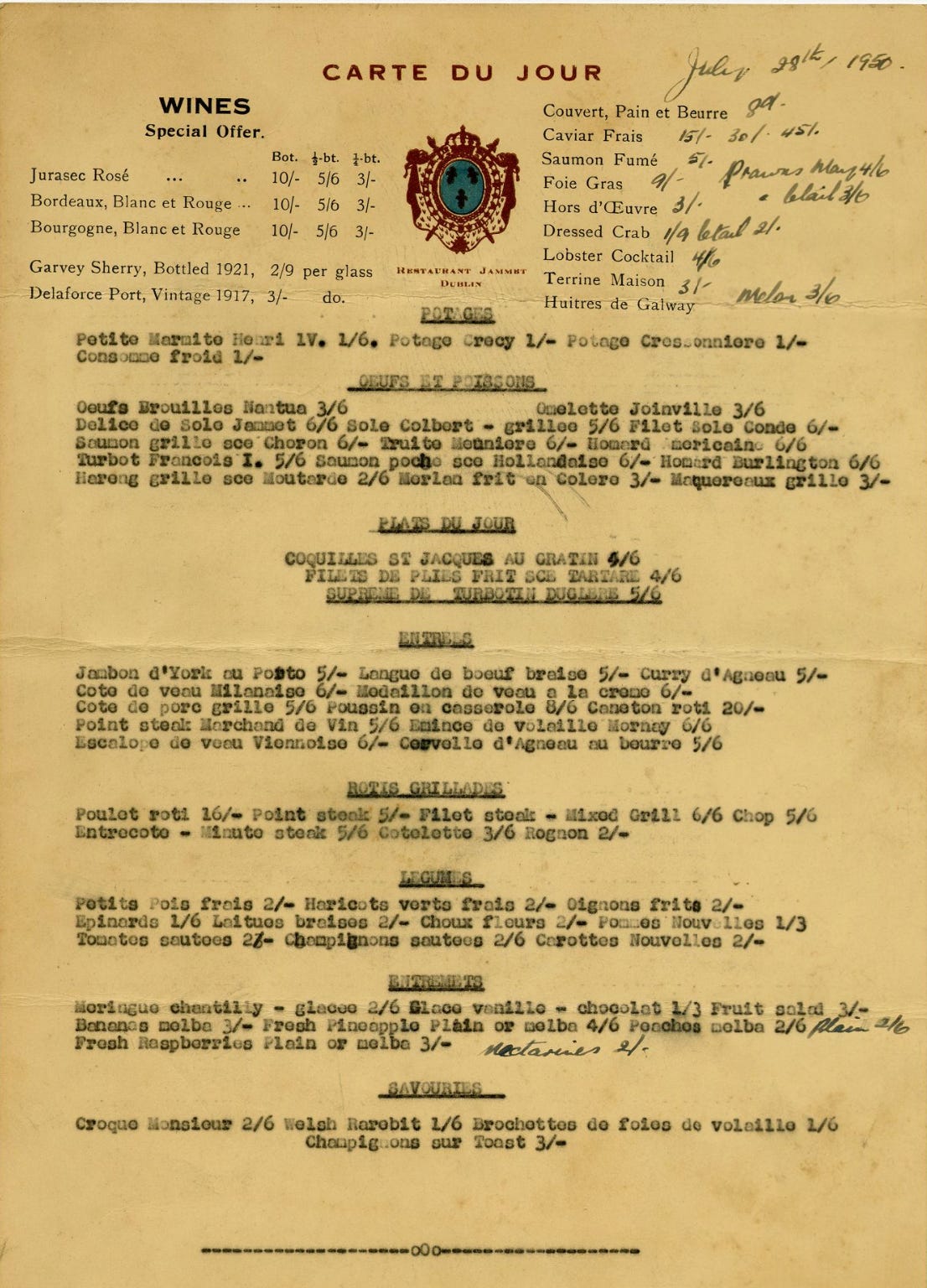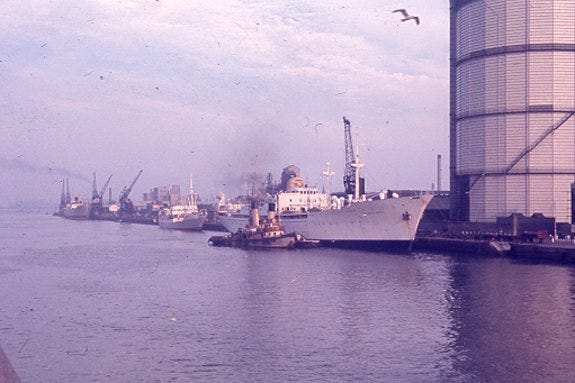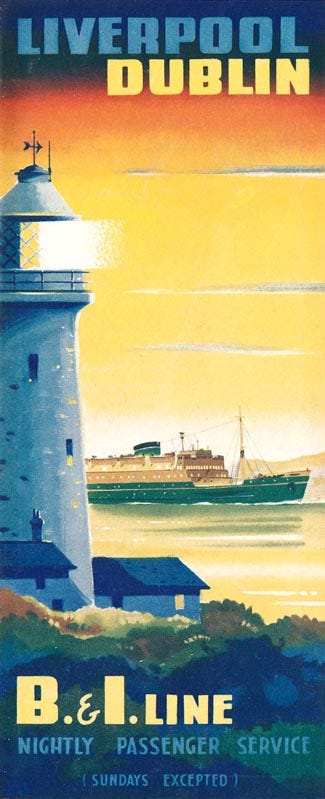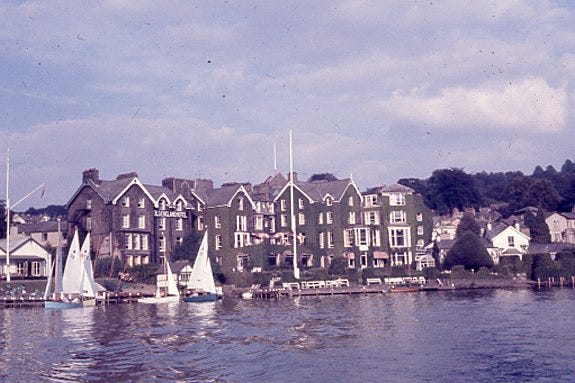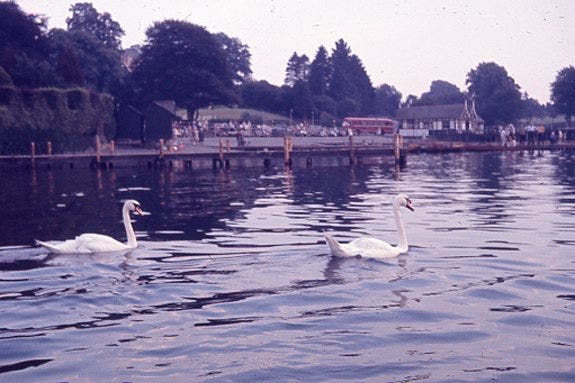#15: August 1963, off to the Lake District
Dresses and dinner in Dublin; swans and boats in Windermere
Thurs. Aug. 1st
Old England Hotel—Windermere
Our last day in Dublin was spent doing odds and ends—mailing packages, calling U.S. Lines, and a little shopping. We went to Sybil Connolly’s—a famous name in dress design. It was interesting. She had some interesting detail in her suits, but most that I saw were much too heavy to wear inside.
Sybil Connolly was a fashion designer known for her innovative use of traditional Irish textiles in haute couture.
For lunch we went to a place called Jammets—a friend of Bertha’s had given her the money to go there. It was expensive—I paid my own! But I never had a better piece of steak in my life. We had tea at the hotel in lieu of dinner. And after the large lunch it was plenty. We had to leave for our boat by 7:00 p.m.
Restaurant Jammet was a famous French restaurant that opened in 1901 and closed in 1967, just a few years after K was in Dublin. It was mentioned in James Joyce’s “Ulysses” and frequented by celebrities. I found a 1960 menu:
Going out of Dublin was interesting. It is a larger harbor than I thought, and very busy. So many cargo boats were there.
Here’s a photo K took—I believe it’s of Dublin harbor, but I’m not sure.
Our boat was not so large as the others—but very sturdy, and steady. It was by far the smoothest trip we have had. When I wakened this morning Bertha said we had stopped—but we hadn’t. It was cargo also—we carried cattle among other things.
From what I can put together, they would have traveled from Dublin to Liverpool on a boat run by the B&I Line—in 1963 this would have been either the Munster or the Leinster.
We had planned to come to Windermere by train, but we found out we could get a bus—and would not have to change. As we got on we learned that each one could have but one piece of luggage—but a little tip changed their mind.
On the bus I rode with a very interesting older man—retired, I judge. We discussed the Cuban situation—the negro problem—the Ward case, etc. He pointed out many interesting things along the way.
Their discussion touched on several major issues of the day—the Cuban Missile Crisis, the civil rights movement (1963 was the year of Martin Luther King’s “I Have a Dream” speech), and Stephen Ward’s involvement in the British political scandal known as the Profumo Affair. I learned that “The Negro Problem” was the title of a 1903 collection of essays by Black American writers, and that in 1963 the phrase was fairly commonly used to describe the issue of racial tension, and the challenges of addressing racism.
Coming into Lancaster he pointed out Lancaster Castle. When we got into Lancaster we had 10 minutes wait—he asked if I should like a cool drink. I said I’d rather see the castle. So he told the driver where we were going and we hiked up—and I mean up—a hill. I thought I was a pretty good walker but I was panting when I arrived at the castle. We stopped long enough for me to take a picture and back we walked—he walked—I trotted!
Lancaster Castle is a medieval castle and former prison, probably founded in the 11th century.
The next man that sat beside me was retired, he told me. He has a nephew in N.Y., a sister-in-law in Los Angeles. He was a pleasant person but didn’t stay on long.
We were put down by the side of the road in Windermere—bags, baggage, and baskets! We had to scout a bit to find a cab.
This is a beautiful hotel. Both of our rooms overlook the lake. The gardens are lovely. I took a picture from each of the rooms. It’s the first time we’ve had much of a view.
The Lake District is a region in Cumbria, North West England. Lake Windermere is the largest lake in England, measuring about 11 miles long and 1 mile wide. Here’s a picture of the Old England Hotel from K’s slide collection.
They served us lunch—tho’ it was after hours. Helen and I walked about the village a bit—I bought an anniversary card, which you should receive before this letter. It’s a rather silly one but I refused to buy a Hallmark one.
K’s sister Ruth (my grandmother) was married to Robert Grooters on 7 Aug 1935 in Grant’s Pass, Oregon. Here’s an account of their wedding from my other family history project, The Journals of Emma Troutman Boylan.
I’ve had a bath, done the laundry, and must get dressed. We made a reservation to take a boat trip on Lake Windermere at 6:30. It is another beautiful day, so it should be a pretty ride. Though as the man on the train said, “There should be a jolly good rain of two days to bring Windermere alive.”
I was sitting on the bed in my robe writing—the door opened and an old man walked in. He couldn’t find his way out!
Later—we had an hour’s ride in a motor launch on the lake. Only the four of us for passengers. There is a large steamer—must carry several hundred—but we took the boat belonging to the hotel. We went at 6:30 p.m.—a beautiful time. The scenery was all that one could wish.
I found this 1962 postcard of the hotel’s passenger launch.
We’ve had dinner. Helen and I went out and sat in the garden a bit. It isn’t late but it has been a long day, albeit a very pleasant one. Tomorrow we plan to go to Grassmere. And now to bed.
Friday a.m.
I wakened hearing a noise I got up to investigate. It was the sweeping of the stone terrace just below my window. More interesting to see were the swans in the lake. There is one family—at least eight babies—cygnets, aren’t they called?—with papa and mama swan riding herd on them.
I found this image of swans among K’s slides from this segment of the trip.
I hope you’ve enjoyed this installment of Travels with K! If you know someone who might like to join us on the journey, please feel free to share. See you next week as K and her friends continue exploring the Lake District and start their journey back to London.




